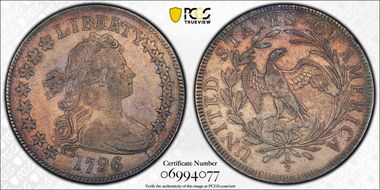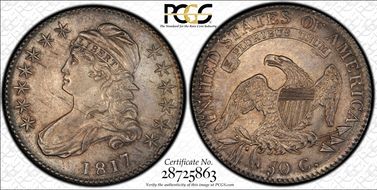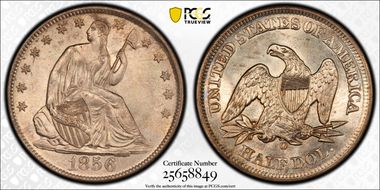Merrill Collection 的钱币相册
O-101, Rarity 4. Old Green Holder (OGH). From Heritage's 2015 January 7 - 12 FUN US Coins Signature Auction - Orlando #1216, Lot 4801.
O-101, Rarity 4. Old Green Holder (OGH). From Heritage's 2015 January 7 - 12 FUN US Coins Signature Auction - Orlando #1216, Lot 4801.
O-110, Rarity 4. This is a condition census coin for the variety with the top 5 being 61,45,45,40,35. Previously offered in Heritage's 2008 September Long Beach, CA US Coin Signature Auction #1116. The present silver-gray piece is noteworthy for its ample shimmering luster and bold hair definition. Impressively undisturbed by abrasions apart from a hair-thin mark near the TAT in STATES. Struck from prominently clashed dies, as usually seen with this variety.
O-110, Rarity 4. This is a condition census coin for the variety with the top 5 being 61,45,45,40,35. Previously offered in Heritage's 2008 September Long Beach, CA US Coin Signature Auction #1116. The present silver-gray piece is noteworthy for its ample shimmering luster and bold hair definition. Impressively undisturbed by abrasions apart from a hair-thin mark near the TAT in STATES. Struck from prominently clashed dies, as usually seen with this variety.
O-101, Rarity 5. From the Heritage, Summer 2008 FUN Auction. The design elements display excellent definition for the grade designation, slightly more so on the obverse. Liberty's hair strands in the middle and lower portions of the portrait are sharp, as is the dentilation on both sides, the sole exception being that on the upper obverse. Strong definition is also noted on about one-half of the eagle's wing plumage, along with that on the tail. Particularly noteworthy is the clarity in most of the diagnostic semi-circular crack above Liberty's shoulder; this fine crack is usually visible only on higher-end VF and better examples. Soft champagne-gold patina accented with whispers of sky-blue and lavender covers both sides, and traces of luster are visible in some of the motif interstices, especially those of Liberty's hair and the eagle's feathers. The surfaces are relatively clean for a coin having seen light to moderate circulation. A couple of inoffensive obverse pinscratches are only mentioned for complete accuracy, and two minute marks near the rim above star 7, one between 9 and 6 in the date, and another to the top right of the 2 in the fraction may help in identifying the coin for future catalogers and researchers.
O-101, Rarity 5. From the Heritage, Summer 2008 FUN Auction. The design elements display excellent definition for the grade designation, slightly more so on the obverse. Liberty's hair strands in the middle and lower portions of the portrait are sharp, as is the dentilation on both sides, the sole exception being that on the upper obverse. Strong definition is also noted on about one-half of the eagle's wing plumage, along with that on the tail. Particularly noteworthy is the clarity in most of the diagnostic semi-circular crack above Liberty's shoulder; this fine crack is usually visible only on higher-end VF and better examples. Soft champagne-gold patina accented with whispers of sky-blue and lavender covers both sides, and traces of luster are visible in some of the motif interstices, especially those of Liberty's hair and the eagle's feathers. The surfaces are relatively clean for a coin having seen light to moderate circulation. A couple of inoffensive obverse pinscratches are only mentioned for complete accuracy, and two minute marks near the rim above star 7, one between 9 and 6 in the date, and another to the top right of the 2 in the fraction may help in identifying the coin for future catalogers and researchers.
O-101, Rarity 5. From the Heritage, Summer 2008 FUN Auction. The design elements display excellent definition for the grade designation, slightly more so on the obverse. Liberty's hair strands in the middle and lower portions of the portrait are sharp, as is the dentilation on both sides, the sole exception being that on the upper obverse. Strong definition is also noted on about one-half of the eagle's wing plumage, along with that on the tail. Particularly noteworthy is the clarity in most of the diagnostic semi-circular crack above Liberty's shoulder; this fine crack is usually visible only on higher-end VF and better examples. Soft champagne-gold patina accented with whispers of sky-blue and lavender covers both sides, and traces of luster are visible in some of the motif interstices, especially those of Liberty's hair and the eagle's feathers. The surfaces are relatively clean for a coin having seen light to moderate circulation. A couple of inoffensive obverse pinscratches are only mentioned for complete accuracy, and two minute marks near the rim above star 7, one between 9 and 6 in the date, and another to the top right of the 2 in the fraction may help in identifying the coin for future catalogers and researchers.
O-102, Rarity 6. PCGS total Pop of 2. From the Heritage, Summer 2008 FUN Auction. A delicate blend of lilac and light golden-gray patina covers both sides. The design elements display strong detail for the grade designation, particularly on the obverse, where many of Liberty's hair strands show. Indeed, the obverse might lay claim to VF definition. On the reverse, about one-third of the feather detail is visible. There are faint adjustment marks at the right obverse border between the stars and the rim, and a scattering of light marks over each side is consistent with a coin having seen moderate circulation. An inoffensive pinscratch running from the eagle's neck to the right (facing) leg is mentioned solely for pedigree purposes, as is one from the leg to the upper part of the palm leaf. The Overton 102 variety of the 1797-dated half is the rarest of the four 1796-1797 die marriages. The laurel leaf extending beneath the base of the second T in STATES and the palm leaf terminating at the lower left serif of the F in OF confirm the variety. Ex: Gary L. Burhop and Mel W. Davis Collections and other important properties (Bowers and Merena, 10/1996), lot 2011. From The Glenwood Collection.
O-102, Rarity 6. PCGS total Pop of 2. From the Heritage, Summer 2008 FUN Auction. A delicate blend of lilac and light golden-gray patina covers both sides. The design elements display strong detail for the grade designation, particularly on the obverse, where many of Liberty's hair strands show. Indeed, the obverse might lay claim to VF definition. On the reverse, about one-third of the feather detail is visible. There are faint adjustment marks at the right obverse border between the stars and the rim, and a scattering of light marks over each side is consistent with a coin having seen moderate circulation. An inoffensive pinscratch running from the eagle's neck to the right (facing) leg is mentioned solely for pedigree purposes, as is one from the leg to the upper part of the palm leaf. The Overton 102 variety of the 1797-dated half is the rarest of the four 1796-1797 die marriages. The laurel leaf extending beneath the base of the second T in STATES and the palm leaf terminating at the lower left serif of the F in OF confirm the variety. Ex: Gary L. Burhop and Mel W. Davis Collections and other important properties (Bowers and Merena, 10/1996), lot 2011. From The Glenwood Collection.
O-101, Rarity 3. From the Sheridan Downey sale of Daniel W. Holmes, Jr. Collection. Previously from the FUN Jan '05 Sale.
O-101, Rarity 3. From the Sheridan Downey sale of Daniel W. Holmes, Jr. Collection. Previously from the FUN Jan '05 Sale.
O-101, Rarity 3. From Heritage's 2010 August Boston, MA Signature & Platinum Night ANA Coin Auction #1143, Lot 3139. Listed as: 1802 Draped Bust Half Dollar, O-101, AU53, Challenging, In-Demand Date. Ex: Garrett-Pryor, 1802 50C AU53 PCGS Secure. O-101, R.3. Only 29,890 Draped Bust half dollars were minted in 1802, and the date is the most difficult to locate of all the Heraldic Eagle half dollars, especially in high grades. Only one die variety is known for the date. The present coin has an illustrious history, linked to three great collections of past years. This example surfaced in the collection of John Colvin Randall, the great 19th century student of die varieties. W. Elliot Woodward sold the collection in 1885. The description in his auction catalog reads, "1802 Uncirculated; brilliant. The finest I have met with; extremely rare. Plate." The lot was sold to T. Harrison Garrett, a director of the B & O Railroad, of Monopoly fame, and the architect of the famous Garrett Collection. The coin later found a place in the James Bennett Pryor Collection, a specialized gathering of half dollars known for the quality and completeness of the collection. The coin offered here is an attractively toned high-grade example, with a sharp strike and minimally abraded surfaces. The surfaces are a pleasing greenish-gray, with touches of rose and blue in areas. Population: 5 in 53, 10 finer (6/10). Ex: John Colvin Randall Collection (Woodward, 6/1885), lot 221; T. Harrison Garrett; John Work Garrett; Johns Hopkins University; Garrett Collection (Bowers and Ruddy, 11/1979), lot 278; James Bennett Pryor Collection (Bowers and Merena, 1/1996), lot 5.
O-101, Rarity 3. From Heritage's 2010 August Boston, MA Signature & Platinum Night ANA Coin Auction #1143, Lot 3139. Listed as: 1802 Draped Bust Half Dollar, O-101, AU53, Challenging, In-Demand Date. Ex: Garrett-Pryor, 1802 50C AU53 PCGS Secure. O-101, R.3. Only 29,890 Draped Bust half dollars were minted in 1802, and the date is the most difficult to locate of all the Heraldic Eagle half dollars, especially in high grades. Only one die variety is known for the date. The present coin has an illustrious history, linked to three great collections of past years. This example surfaced in the collection of John Colvin Randall, the great 19th century student of die varieties. W. Elliot Woodward sold the collection in 1885. The description in his auction catalog reads, "1802 Uncirculated; brilliant. The finest I have met with; extremely rare. Plate." The lot was sold to T. Harrison Garrett, a director of the B & O Railroad, of Monopoly fame, and the architect of the famous Garrett Collection. The coin later found a place in the James Bennett Pryor Collection, a specialized gathering of half dollars known for the quality and completeness of the collection. The coin offered here is an attractively toned high-grade example, with a sharp strike and minimally abraded surfaces. The surfaces are a pleasing greenish-gray, with touches of rose and blue in areas. Population: 5 in 53, 10 finer (6/10). Ex: John Colvin Randall Collection (Woodward, 6/1885), lot 221; T. Harrison Garrett; John Work Garrett; Johns Hopkins University; Garrett Collection (Bowers and Ruddy, 11/1979), lot 278; James Bennett Pryor Collection (Bowers and Merena, 1/1996), lot 5.
O-101, Rarity 3. Condition Census Top 5. Dramatic die clashing observed on both sides. Lustrous with slight toning.
O-101, Rarity 3. Condition Census Top 5. Dramatic die clashing observed on both sides. Lustrous with slight toning.
O-113A, Rarity 4, Condition Census Top 5 (50,50,40,40,40). From Bowers and Merena The 2009 ANA National Money Show Auction Session One, Auction # 13170, Lot #666. This richly original example exhibits blended olive-gray and lavender-charcoal patination. A well-balanced piece, we also note bold devices and a lack of detracting abrasions for both sides. A scarce die marriage, this coin is included in the Condition Census for the O-113a variety as listed by Stephen J. Herrman in the Autumn 2008 revision to Auction & Mail Bid Prices Realized for Bust Half Dollars: 1794-1839. Previously from Heritage's sale of the Westmoreland County Collection of Early Bust Halves, January 2008, lot 1363. Previously from the Heritage 2008 January Orlando, FL (FUN) Signature Coin Auction #454, Lot 1363. 1805 50C AU50 PCGS. O-113a, High R.4. The 'non-a' O-113 does not exist even though it is still included in the fourth edition of Overton. The difference between O-113 and 113a is listed as 12 arrows on the reverse of 113 and 13 arrows on the reverse of 113a. This listing seems illogical since one would expect die wear or die polishing would remove arrows, not add them. Like O-111 and 112, this is another single-use reverse that is paired with Obverse 7. This coin is an intermediate die state with a light crack through the tops of MERI. Deep steel toning with splashes of dark gold on the highpoints, mask the considerable luster that is still present on both sides of this piece. There are no AU50 coins listed on Herrman's Auction & Mail Bid Prices Realized. However, there is one AU58/58 coin listed, and six AU55/55 pieces. Given the number of AU pieces recorded, one may deduce that a relatively large number of this variety was set aside shortly after production. Nevertheless, there are few pieces in absolute terms. Haseltine-12; Beistle 5b-H; Overton-23; Ex: Robert Zornes (4/2000). From The Westmoreland County Collection of Early Bust Halves, 1794-1807.
O-113A, Rarity 4, Condition Census Top 5 (50,50,40,40,40). From Bowers and Merena The 2009 ANA National Money Show Auction Session One, Auction # 13170, Lot #666. This richly original example exhibits blended olive-gray and lavender-charcoal patination. A well-balanced piece, we also note bold devices and a lack of detracting abrasions for both sides. A scarce die marriage, this coin is included in the Condition Census for the O-113a variety as listed by Stephen J. Herrman in the Autumn 2008 revision to Auction & Mail Bid Prices Realized for Bust Half Dollars: 1794-1839. Previously from Heritage's sale of the Westmoreland County Collection of Early Bust Halves, January 2008, lot 1363. Previously from the Heritage 2008 January Orlando, FL (FUN) Signature Coin Auction #454, Lot 1363. 1805 50C AU50 PCGS. O-113a, High R.4. The 'non-a' O-113 does not exist even though it is still included in the fourth edition of Overton. The difference between O-113 and 113a is listed as 12 arrows on the reverse of 113 and 13 arrows on the reverse of 113a. This listing seems illogical since one would expect die wear or die polishing would remove arrows, not add them. Like O-111 and 112, this is another single-use reverse that is paired with Obverse 7. This coin is an intermediate die state with a light crack through the tops of MERI. Deep steel toning with splashes of dark gold on the highpoints, mask the considerable luster that is still present on both sides of this piece. There are no AU50 coins listed on Herrman's Auction & Mail Bid Prices Realized. However, there is one AU58/58 coin listed, and six AU55/55 pieces. Given the number of AU pieces recorded, one may deduce that a relatively large number of this variety was set aside shortly after production. Nevertheless, there are few pieces in absolute terms. Haseltine-12; Beistle 5b-H; Overton-23; Ex: Robert Zornes (4/2000). From The Westmoreland County Collection of Early Bust Halves, 1794-1807.
O-109A, Rarity 3. From Stack's Nov 10, 2009, The 74th Anniversary Sale, Lot 1359. Listed as: The present coin is graded AU-58 by PCGS and we consider it to be a high-end piece, comparing quite favorably to more than just a few half dollars of this type that are in the Mint State category. Moreover, the obverse is attractive lavender and gray and the reverse is medium gray, with much underlying mint frost. An outstanding coin worthy of a strong bid. Formerly from Heritage's 2006 September Long Beach, CA Signature Auction #416, Lot 1868.
O-109A, Rarity 3. From Stack's Nov 10, 2009, The 74th Anniversary Sale, Lot 1359. Listed as: The present coin is graded AU-58 by PCGS and we consider it to be a high-end piece, comparing quite favorably to more than just a few half dollars of this type that are in the Mint State category. Moreover, the obverse is attractive lavender and gray and the reverse is medium gray, with much underlying mint frost. An outstanding coin worthy of a strong bid. Formerly from Heritage's 2006 September Long Beach, CA Signature Auction #416, Lot 1868.
O-112, Rarity 1. CAC Approved. From Heritage's 2009 March Baltimore, MD Signature US Coin Auction #1126, Lot 1934. Golden-brown and ocean-blue adorn the reverse margin, while the obverse is comprehensively toned in gunmetal-blue and cream-gray. A slender strike-through (as made) reaches the S in PLURIBUS, but actual marks are minor and hard to locate.
O-112, Rarity 1. CAC Approved. From Heritage's 2009 March Baltimore, MD Signature US Coin Auction #1126, Lot 1934. Golden-brown and ocean-blue adorn the reverse margin, while the obverse is comprehensively toned in gunmetal-blue and cream-gray. A slender strike-through (as made) reaches the S in PLURIBUS, but actual marks are minor and hard to locate.
O-101A, Rarity 3. From Stack's Orlando Auction, 1/05/2009 - Medium gray and lilac toning over lustrous surfaces, with some hints of blue around the border. A lovely example, indeed one of the finest graded by PCGS, of this key issue. Among the different years in the Capped Bust series, continuously from 1807 to 1836, except for 1816 (when none were minted), the 1815 is far and away the scarcest. All are from a single die, overdated as 1815/2.
O-101A, Rarity 3. From Stack's Orlando Auction, 1/05/2009 - Medium gray and lilac toning over lustrous surfaces, with some hints of blue around the border. A lovely example, indeed one of the finest graded by PCGS, of this key issue. Among the different years in the Capped Bust series, continuously from 1807 to 1836, except for 1816 (when none were minted), the 1815 is far and away the scarcest. All are from a single die, overdated as 1815/2.
















































































